The Rise of Megafires
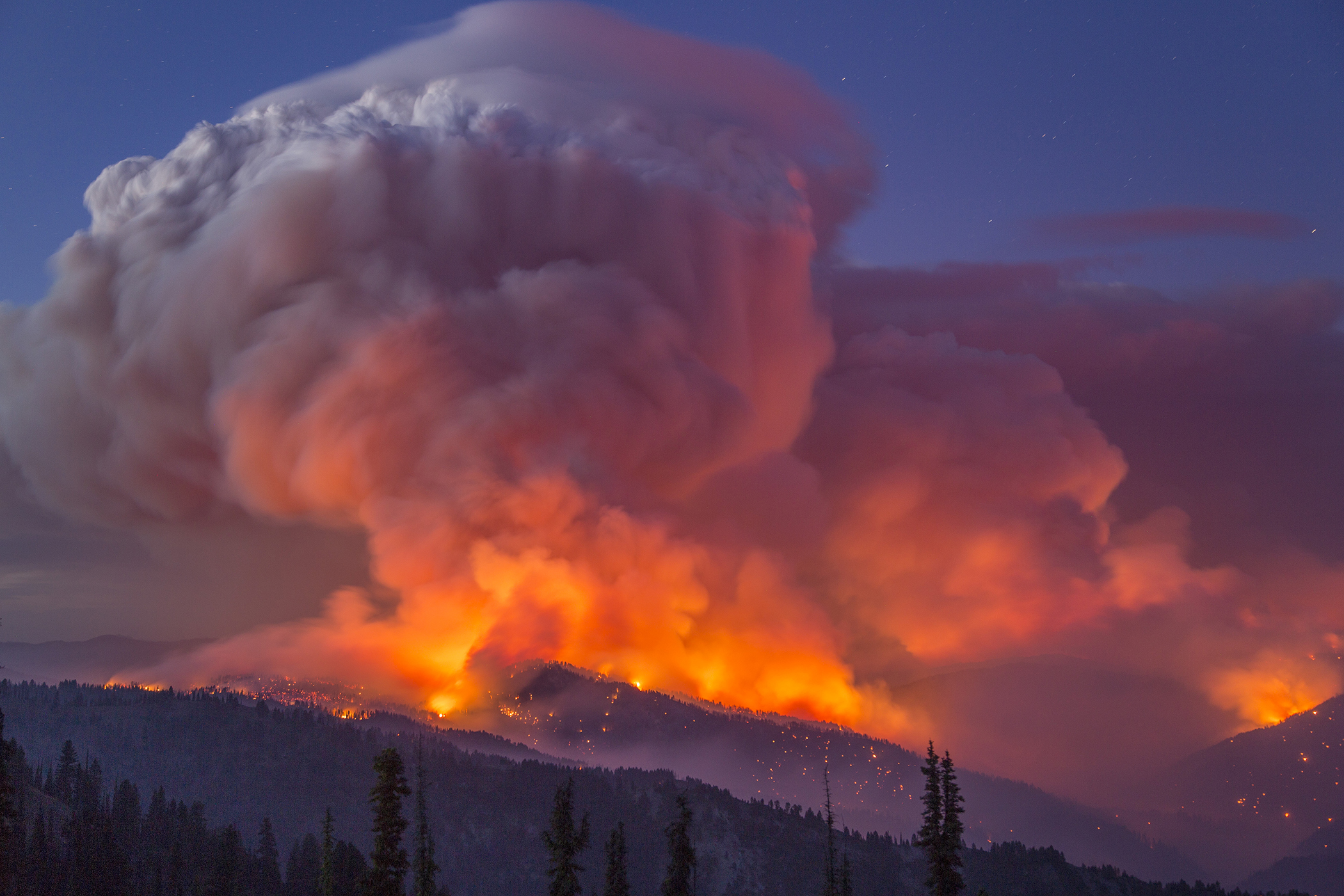
The Pioneer Fire explodes in Boise, Idaho, in 2016. Photo by Kari Greer, USFS.
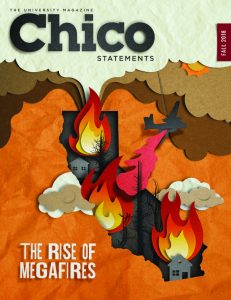
Editor’s note: This article was published on November 5, 2018, and delivered to mailboxes that week as the cover story of Chico Statements.
Days later, on November 8, the deadliest and most destructive fire in California history blazed across Butte County, destroying the town of Paradise and neighboring communities while driving flames to the edge of Chico city limits.
The timing, while eerie and heart-wrenchingly apropos, was part of a concept months in the making. The Rise of Megafires was prompted by other devastating blazes that had rocked urban communities such as Redding and Santa Rosa, and a desire to better understand what’s happening, why, and how we can respond as wildfires grow faster, larger, and more deadly every day.
The story has been updated to reflect the Camp Fire’s rise to infamy among the ranks of megafires—a designation no community ever wants for its own.
Tornado-like winds swirling around her, this evacuation felt different.
“We stepped out our front door and we could see it. You could see flames, you could see smoke, you could see black spirals that you would assume were structures just literally going up in smoke,” said Shannon Phillips (Psychology, ’81). “This was a roaring fire.”
Into the car went baby books for her and her husband’s three children, any photos they didn’t have digitally, an heirloom coin collection, insurance papers, and jewelry, in case the flames came closer.
That was at 5:30 p.m.
Two hours later, the power went out and her neighbors pounded on the door.
“Go now, and don’t even think twice about it. Just get out,” they directed Phillips, who had been evacuated once 14 years earlier, but only for a few hours.
“There was so little time to think clearly,” she said. “I just looked at the house and thought, ‘What’s replaceable?’ and let the rest go.”
The Carr Fire started on a Monday, July 23, sending up white plumes 15 miles west of Redding. By Thursday, it had become a firestorm, ravaging forests and consuming everything in its path as it exploded in size and raced toward suburbia. Quickly surpassing 100,000 acres, it classified as a megafire—a designation once rare but now routine.
As Phillips fled the encroaching flames, junior Shane Kaylor was defying evacuation orders after his parents urged him to return home to help. The Chico State business administration major thought the likelihood of the blaze jumping the Sacramento River and reaching their house in a suburban neighborhood was so slim, he packed his Xbox to pass the time. Hours later, he was fighting flames with a water cannon alongside his father, a retired fire chief, in hopes of saving their family’s home.
“You don’t believe it can happen to you—until it does,” he said. “It felt like a storm but instead of rain it was smoke and flames. It was like a campfire you wouldn’t believe. You could hear it almost roaring.”
By the time the Carr Fire was contained five weeks later, it had ravaged 229,651 acres, destroyed more than 1,000 homes, and killed eight people. For those the fires touched—Phillips and Kaylor among them—their lives were forever changed.
To firefighters, these blazes represent the new normal: Six of the state’s most destructive fires, five of the deadliest, and four of the largest have taken place in just the last two years.
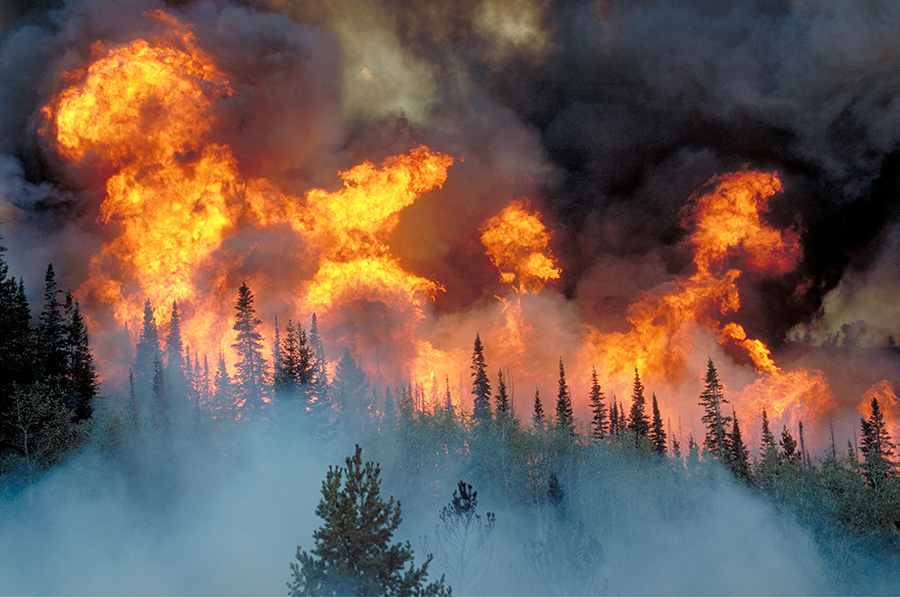
UP IN SMOKE
“We are experiencing larger and more damaging fires in this century,” explained Judith Downing (Recreation Administration, ’83), a 36-year US Forest Service veteran. “These fires are becoming more dangerous—and they are more costly. They are a pretty severe wake-up call to all of us in fire and land management agencies, as well as the public.”
Downing has seen countless fires in her career. She battled them firsthand as a wildland firefighter during her summers as a college student, explained them to citizens during her years as a public information officer, and worked to limit human-caused wildfires as a prevention officer. Today, she works in wildland fire management, based out of Washington, DC.
“It’s one thing to talk about the fires, but it’s another thing to talk about how we address them—and there are solutions out there,” she said. “With these megafires, there are many effective actions in our current national strategy. But we are also seeing things we have never seen before.”
Adding to their impact is the sheer volume of smaller fires, the combined acreage they consume, and the destruction they leave in their wake. As of late October, nearly 1.5 million acres had burned in California this year—three times the annual average—with what is historically one of the most active fire months still to come. One month later, the Woolsey and Camp Fires alone would add another 250,000 acres to that total.
With low humidity and whipping winds that start earlier every year, “California doesn’t really have a fire season anymore—it just has peaks and lulls in fire activity,” said Napa County Fire Chief Barry Biermann (Communication Studies, ’91), who spent the last decade of his 32-year Cal Fire career working on a statewide incident management team.
Though late 2017 contained some of the most devastating fires in state history, as the Nuns, Tubbs, and Redwood Valley Complex Fires destroyed thousands of homes and took dozens of lives in October, it didn’t mark the end of fire activity for the season.
“When we thought it could not get any worse after what happened in Sonoma, Lake, and Napa Counties, the largest fire happened in December and January in Southern California,” Biermann said.
That 280,000-acre Thomas Fire didn’t hold the record for long. This summer’s Ranch Fire far eclipsed it, with the blaze not fully contained until it had burned 410,000 acres in Mendocino County.
The Camp Fire, which broke out in Butte County on November 8, would ravage just 153,336 acres during the 17 days before it was contained, but its death toll and structural devastation were three times worse than the wildfires that preceded it.
“Everything is being evaluated to figure out why these fires are so large, and things we can do to stop it,” said Biermann, who was among its first responders.
FANNING THE FLAMES
Despite years of prevention efforts, nearly 9 out of 10 fires are still caused by humans. Arson, illegal or untended campfires, roadside sparks from vehicles or dragging chains, and countless other people-driven factors continue to spark catastrophic fires every year.
“The biggest and best thing we can do is stop these fires from starting. If we can stop a few, the cost alone—financially and in lives lost—is a win,” Biermann said. “We need to get the word out to make sure people are not out there doing the right thing at the wrong time.”
Regardless of how the fires start, changing conditions drive the sheer magnitude and exponential damage now witnessed with alarming regularity.
Federal and state agencies, scientists, and others point to many causes for these extreme fire conditions: climate change, warmer temperatures, drier weather, drought, and insect infestations. Add swaths of dead and dying forests and overall vegetation buildup creating massive fuel loads, and the landscape has become a tinderbox.
Meanwhile, more people are living closer than ever to high-risk wildfire areas.
As California’s population continues to swell, many residents are moving to areas where cities and suburbs border wildlands and forests. An estimated 4.4 million people now live in the wildland-urban interface, with another 1.2 million homes projected to be built in the highest wildfire risk areas by 2050. This state is certainly not alone, with similar conditions taking place across the Western United States.
Ultimately, addressing megafires takes implementation of a cohesive national fire management strategy created in partnership among federal, state, nonprofit, private, tribal, and local agencies, Downing said.
“What we are trying to do is look across the boundaries of our jurisdictions to see how we can work on these things together,” she said. “A big piece of that is to use the best available science in making our decisions. And we do that through collaboration.”
This national strategy’s goals are threefold.
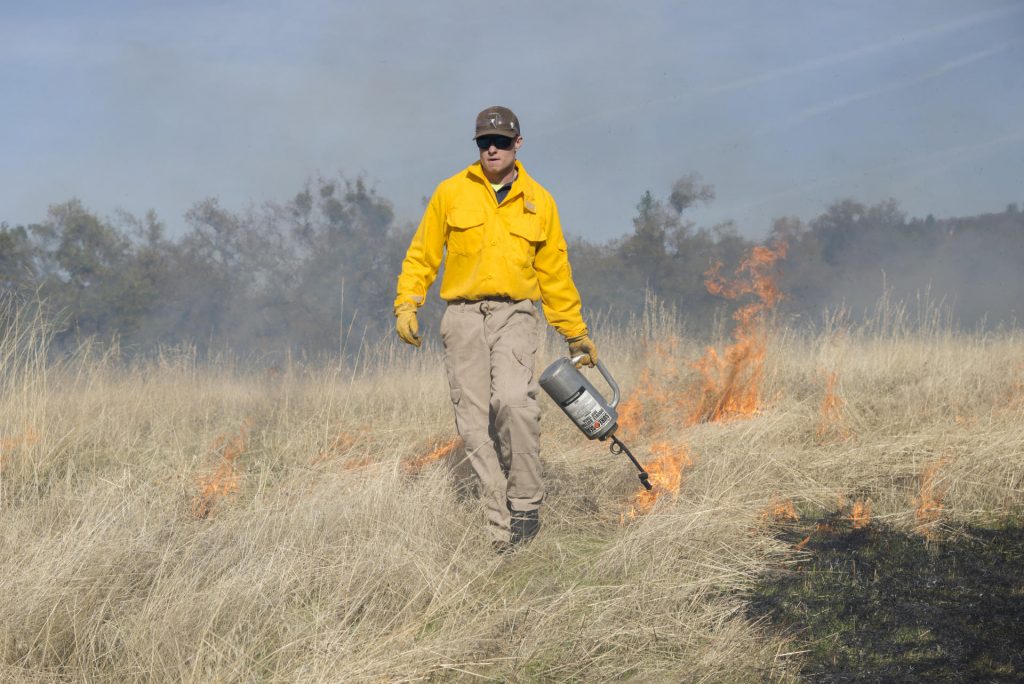
First, create more fire-resilient landscapes, including the reduction of fuels by increases in prescribed burning and a renewed focus on forest thinning.
Secondly, strengthen fire suppression resources and improve
the speed and effectiveness of communication, whether about evacuation, fire conditions, or other impacts of large-scale fires, Downing said. Other needs include creating safety zones for evacuees and earlier detection of fires in wildland-urban interfaces.
Lastly, continue growing fire-adapted communities through government, nonprofit, and tribal partnerships. Solutions include ignition-resistant roofing materials and mandatory attic vent screens, as well as landscaping buffers, growing free wood-chipping programs, and reimagined neighborhood layouts.
Together, Downing said, the goal is that a fire could burn through an area safely—reducing life and property loss and damage to natural and cultural resources. “Prevention really is all of our responsibility,” she said. “From the government, to the community, to the individual person who is out taking a hike in the forest.”
FIGHTING FIRE WITH FIRE
In Chico State professor Don Hankins’ “Pyrogeography” course, he and his students spend part of their instructional hours in the field. Whether studying burn scars on pine trees or igniting the forest floor with a drip torch, he hopes students will walk away with an understanding and respect for the power of prescribed burning.
“It really takes a community embrace,” he said. “It’s not just about putting fire on the ground. It’s doing it in a way we can achieve the greatest good for the landscape.”
Hankins, who has taught in the Department of Geography and Planning for 13 years, has been fascinated with fire since childhood, but his interest grew as he studied how Native Americans have used flames as a tool for thousands of years. Fire is used to manage the meadows and forests, support healthy deer populations, ensure thriving grasses for weaving and basketry, and protect acorns and other traditional food sources.
And, of course, it creates manageable fire breaks. Mechanical controls to address thick forests—whether logging or thinning by chainsaw—are helpful but only a short-term solution, Hankins said.
“You still have to come back at some point with fire,” he said. “The match is the cheapest and easiest tool, and it will have the best ecological benefit.”
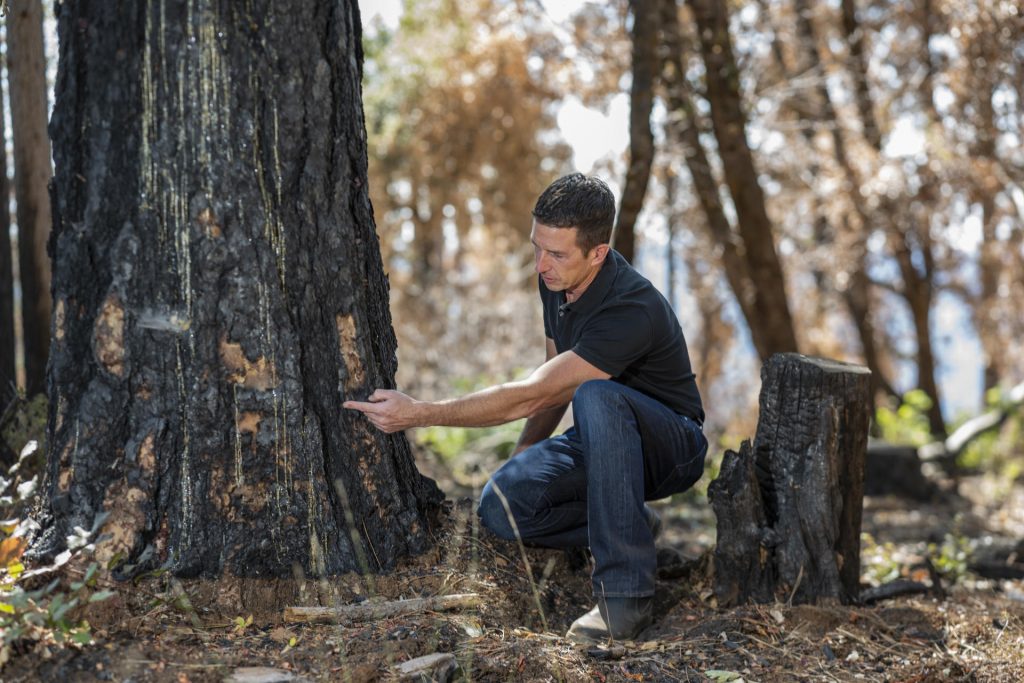
An international expert in the field of prescribed burning, Hankins has worked with indigenous populations on burning projects in Australia, written grants for burns on public lands, and drafted federal policy that supports tribal partners in carrying out burning projects in national forests and other public lands.
Revisiting a project site 20 minutes east of Chico, Hankins points to bracken ferns sprouting lush from the blackened soil. Invasive blackberries are gone and blue wild rye and other native grasses are growing in their place.
Unlike the uncontrolled burning of wildfires, which can decimate the environment as nature corrects itself, prescribed fire can creep slowly through to safely and effectively reduce the amount of fuel available to burn, Hankins said.
“We know it’s going to burn but we can shift it to put terms in our favor,” he explained.
Prescribed burning can be used to reduce vegetation near power lines, roadways, and other access points where fires often start, as well as across forests and around homes to reduce the dangers.
Sunset magazine published an article in 1910 that extolled the virtues of prescribed burning. And yet, Hankins said, attitudes have shifted toward general public opposition to burning on public and private land.
“We need to give people the sense that we can do this,” he said. “It’s been done. It’s not so scary, and it’s going to get us what we need.”
Hankins’ dream is to use the Big Chico Creek Ecological Reserve as an experimental landscape where landowners can learn how to manage fuel loads, noting he recently helped secure two grants with Cal Fire and other partners to conduct burning projects on the reserve. With 15 vegetation communities, each with its own fire needs, it offers learning opportunities for professionals and citizens alike, whether in oak woodlands, mixed conifer forests, grasslands, or chaparral.
He also has visions for establishing the University as an educational center and creating a specialized major.
“Students can be the next generation of fire stewards, thinking about the landscape and the ecological and social impacts,” he said.
THE GOOD IN GRAZING
A trained geneticist, animal scientist, and sixth-generation rancher, agriculture professor Kasey DeAtley (Agriculture, ’06) is looking at another fire mitigation tool: grazing.
Using cattle, sheep, and other animals is economical and effective, she said. Ranchers benefit from a food source for their animals, while the grazers curtail invasive weeds and nonnative species, allow native plants and wildlife to thrive, promote new growth, and reduce the accumulation of fuel so that when fires do burn through, they don’t burn as intensely or do as much damage.
“We could manage rangeland where a lot of these fires could be prevented or a fire could at least be fightable, not just a get-out-of-the-way situation,” DeAtley said. “Cattle and sheep grazing are just one tool in a big toolbox, but it is one that is underutilized.”
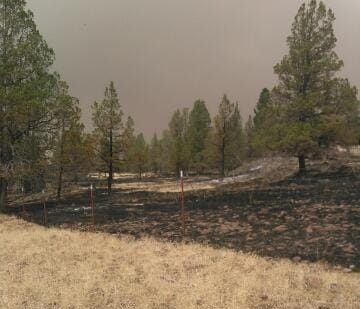
She describes a scene from the Stone Fire, which burned nearly 40,000 acres in Modoc County this summer. After ripping through impenetrable forests and unmaintained grassland, the fire stopped at the grazing line as if a load of retardant had been dropped.
“It didn’t have enough energy,” she explained. “We can create change. We just need to figure out a way to do it and do it effectively.”
Like prescribed burns, grazing was a common method of controlling the grasslands and forests during the 1800s, DeAtley said. But overgrazing and mismanagement devastated the rangeland, and California has spent the last century trying to recover.
Unfortunately, the federal regulation that intends to protect damage from overgrazing has become so extensive that it is now a deterrent and barrier for many, DeAtley said. She has wanted for years to secure a federal grazing permit for the 100-cattle herd her family has in Lassen County, but environmental regulations, agency approvals, and expense have her reconsidering.
It’s a difficult decision when DeAtley knows
the mutual benefits. After years of researching rangeland science and management, she sees prime opportunity to increase grazing in partnership with wildfire ecology and management.
Like Hankins, she also sees students as the stewards to carry that tool into reality. As tragic as the recent surge in megafires has been, she said, her hope is that it spurs a tidal shift in attitudes and behaviors. “Wildfire resonates with everybody in California. It doesn’t matter if you live in downtown San Francisco, LA, San Diego, or rural places like McArthur,” she said. “This is an opportunity to change … and I think education is a good place to start.”
RISING FROM THE ASHES
Remembering and learning from fire history is imperative not just for controlling blazes but being ready for them, Biermann said.
“You need to not forget this event in five, 10, 20 years,” he said. “When you live in that rural area of California or that urban interface where the wildland can burn, you need to be prepared all the time. It’s not a matter of if, it’s when.”
The reality, he said, is the 2018 Atlas Fire in Napa had the same footprint as another blaze by the same name in 1981, and the Tubbs Fire that leveled areas of Santa Rosa tore across the same fire footprint of the Hanley Fire of 1964. Both were fueled by high winds, dry conditions, and challenging topography.
“We have to look at everything in totality and long-term sustainability of whatever we do to react to these fires,” Biermann said. “We need to use safe and sound facts and scientific data moving forward and not just the emotional response.”
When Phillips was finally allowed to return to her neighborhood 10 days after fleeing the Carr Fire, she faced an eerie scene. Amid the piles of crumbled stucco, warped metal, and the skeletons of washing machines and mattress springs were few remnants of the lives once in their place.
“You just go from one lot to the next and basically everything was gone,” Phillips said. “What hit me were the number of vehicles that were burned and left behind. … It felt like a war zone.”
The scene was similar in Kaylor’s neighborhood. He and his dad estimate they saved six homes on their block that night, including their own, but they could not protect them all. The inferno that passed through left little more than torched trees, empty lots, and views of blackened hillsides.
From young families to the city police chief, Phillips has lost count of how many people she knows who lost everything—and she still marvels at how close she came to being one of them. The ruins of other lives start just three houses down from hers. As she walked into her home, she faced bittersweet relief at the sight of the table where her family had shared holiday meals and photos brightening the walls as she realized it all could have been gone in an instant.
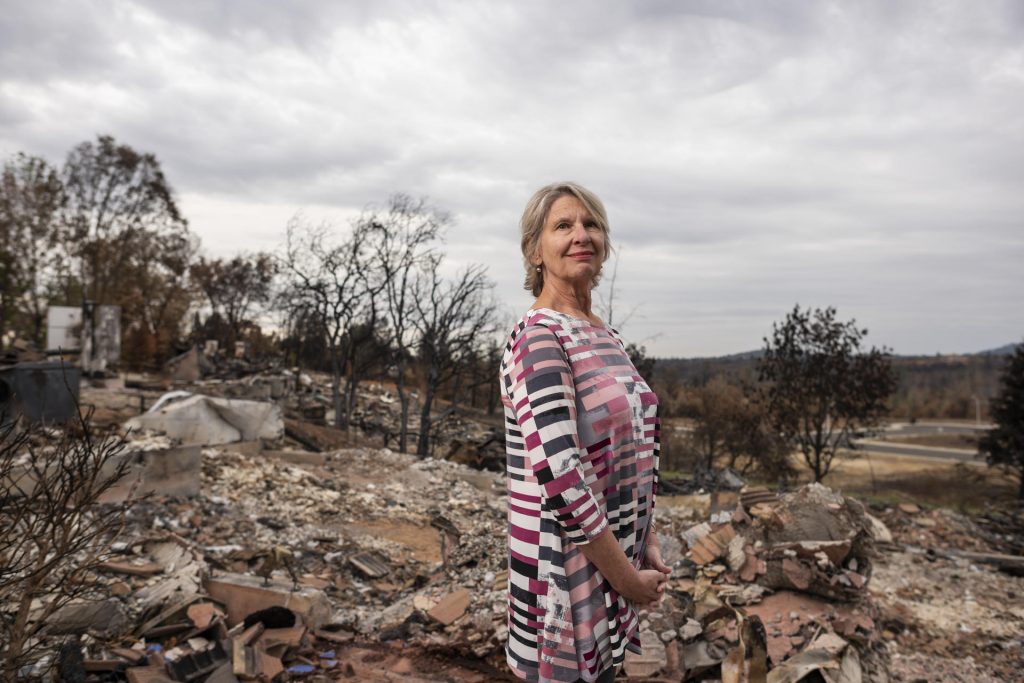
Six weeks later, as she walked the streets of her neighborhood, the smell of smoke still lingered in the air and machinery rumbled as it cleared lots of their toxic remnants. Phillips pointed to small glimpses of hope among the ashes: a burst of pink blooms opening in a flowerpot, the redwood trees on someone’s lawn sprouting bright green new needles, lots being readied for homeowners who were forging forward with plans to rebuild.
“We are stronger than the Carr Fire,” she said. “I think we are going to come out of it a stronger, better community.”
As chief operating officer of the McConnell Foundation, a nonprofit that provides philanthropic support to the surrounding community, Phillips is intimately involved in recovery efforts. In addition to allocating foundation resources for short-term cash assistance, longer-term support, and erosion prevention, she also is engaged in conversations about fire-wise rebuilding, reforestation, and trail restoration in the fire-scarred forests.
“We can make some healthy choices today so that 10 years from now or the next time a fire comes through our community, we learned from this experience and we are less susceptible to a repeat,” she said.
Finding a small, slightly warped metal sunflower in the remnants of her neighbors’ front porch, she pocketed it, with plans to repaint it and give it to the owners as a gift. Phillips’ heart aches, she said, knowing the struggles still to come.
“There is a bit of community-wide depression that hits three months after the fire. It’s a little like grief. We get through the loss of a loved one, we get through all the things on the to-do list, then the reality hits that they are gone permanently,” she said. “We are committed to the long haul in staying engaged in our recovery.”


